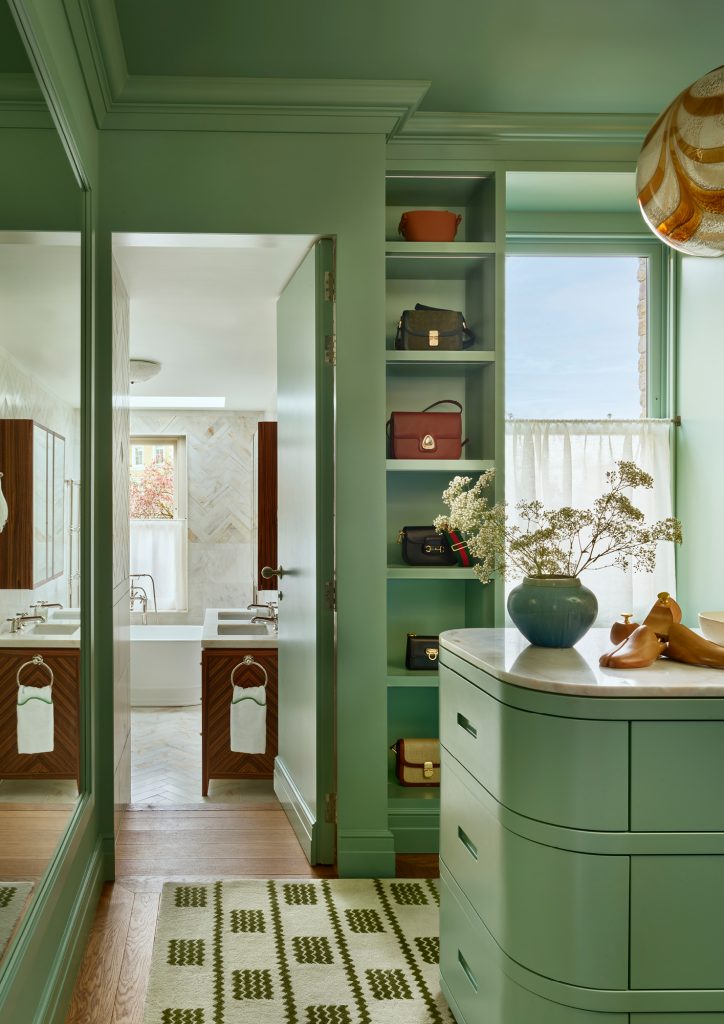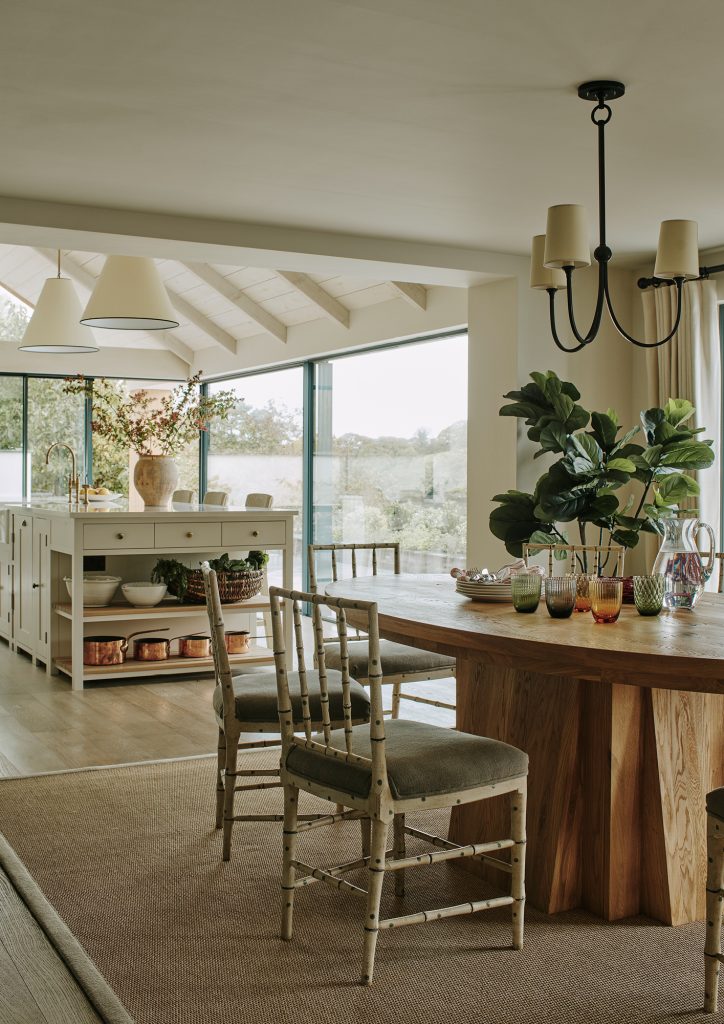From ceilings as the new design frontier to the return of silver metals, rich wood tones, and punchy patterns, interior design experts reveal to Brummell how contemporary spaces are evolving
As the seasons shift, so too does the world of interiors, with spring/summer 2025 bringing a rich tapestry of textures, tones and time-honoured craftsmanship to the forefront. This year, interiors are warmer, more tactile and deeply personal – putting sculptural forms, organic materials and expressive details firmly in the spotlight.
To explore the trends shaping the season ahead, we turn to three leading designers defining modern luxury: Portia Fox, founder and creative director of Portia Fox, who has a passion for textiles and understated luxury; Emma Sims-Hilditch, content creator and founder of Sims Hilditch, known for her British country aesthetic; and Alícia Meireles, creative director at OWN LONDON and a Chelsea College of Art & Design graduate.
What are the key interior trends for spring/summer 2025 that you’re most excited about?
Portia Fox: Interiors are embracing a warmer, more tactile aesthetic, with a growing appreciation for craftsmanship and unconventional art forms like ceramics, pottery and sculpture. This shift is reflected in paint and wallpaper choices featuring ochre and terracotta undertones, the use of richer wood tones and a return to solid wood with open grain instead of dyed veneers. Organic materials, such as ceramic, are also being integrated into everyday furniture pieces like cabinets and coffee tables, exemplified by The New Craftmaker’s drinks cabinet.
Emma Sims-Hilditch: We are starting to see a strong demand for texture. Whether it’s a rough stone wall or a wool bouclé cushion, tactile materials are playing a key role in interiors.
The modern farmhouse aesthetic continues to be popular, blending mid-century, antique and contemporary furnishings for a layered look. Glossy surfaces and sleek, flat-fronted kitchens are being replaced by painted wood or oak cabinetry, which offer a more organic, natural feel.
Alícia Meireles: Products with punchier finishes like metallic pendants and glossy, handmade ceramic wall lights are becoming more popular. I’ve also seen the rise of printed fabrics, which is a budget-friendly way of injecting patterns into a room.

Are there any colours, materials or design elements you predict will dominate this season?
PF: We’ve recently noticed a focus on ceiling design. Ceilings are no longer an afterthought but an integral part of a room’s identity. As colour drenching gained popularity in 2024, extending bold creativity to ceilings is the next logical step. In 2025, designers are set to embrace the ceiling as a “fifth wall”, where elements like hand-painted murals, sculptural ceiling roses and deep cornices can elevate the entire room’s aesthetic.
AM: It might just be my personal preference, but I’ve noticed a trend towards natural, warm colours like warm whites, soft ambers and terracottas, often paired with timber. People are then adding a pop of vibrant colour to break up the warmth and add contrast. Yves Klein Blue, one of my all-time favourites, is making a comeback, while cooling greens and yellows are also gaining popularity. Additionally, natural materials such as earthy terracotta tiles and hand-applied, polished plasters are having a moment this season.

Sustainability is a growing focus in design. How do you see it shaping interiors in 2025?
PF: We’re incredibly lucky that in London we have a wealth of world-class artisans, craftspeople and makers on our doorstep. Prioritisation of quality craftsmanship is synonymous with sustainability, as the quality and longevity of hand-crafted items will far outlive those that are mass produced. Pieces are able to become heirlooms that can be passed down from generation to generation. We therefore always advocate buying once and buying well.
ESH: Longevity is seen as the principal form of sustainability. Antiques embody a sense of history and heritage, reduce waste and save energy on new production. Beautiful, natural materials are integral to the studio’s design ethos, so when the team does procure new pieces, the focus is on using organic and renewable materials that can naturally regenerate within their lifetime.
AM: In a world where sustainability is so important, the more local you can go when you’re sourcing materials – including construction materials – the better. Using local materials and craftsmanship also helps tell the story of the area and brings a sense of place to projects.
Vintage pieces also help to bring uniqueness to a project and always improve a space. They’re highly sustainable as they’ve already been around for a long time and each piece tells a story. They’re beautiful to look at and it’s interesting to adapt them into a new space – they make it feel alive.

What’s one trend from the past that you think is making a strong comeback?
PF: I think we are going to see silver metals make a comeback. For a long time, warm bronzes and golds have been the go-to metal choice throughout a project but there is a shift towards silver to bring some edge and modernism to softer interiors. This can be achieved through hammered silver materiality in furniture, polished nickel or platinum in lighting and sanitaryware and brushed steel in joinery.
ESH: Mahogany, popular in Georgian and Victorian homes, is often linked to traditional interiors. However, brown furniture has a strong place in today’s interiors, adding warmth, depth and a curated old-meets-new contrast. These pieces carry a story, a sense of history and an authenticity that elevates a design beyond the purely decorative.
AM: Art Deco influences are resurfacing in a fresh, modern way – think bold geometric patterns, rich jewel tones and luxurious materials like marble and brass. This year marks a century since the inception of Art Deco, and it remains as relevant today as it was then. I am consistently drawn to the movement’s ability to blend functionality with artistic expression, creating interiors that are visually striking and lavish in their meaning. It’s a style that adds glamour to any space.
How do you balance timeless design with current trends?
PF: Timeless design is about creating interiors that retain their beauty and functionality for years to come, while trends can provide fresh inspiration and keep spaces feeling contemporary. My approach is to focus on architectural integrity and classic proportions as a foundation, then layer in elements that reflect current design movements in a way that feels natural and not overly trend driven. For example, I might incorporate an of-the-moment colour or material in a way that can be easily updated, such as through upholstery, accessories or art. The key is ensuring that any trend-led addition enhances rather than dictates the overall aesthetic, so the space remains elegant and relevant long term.
ESH: Timeless design is about creating spaces that feel effortless and enduring rather than dictated by passing trends. We achieve this by focusing on quality craftsmanship, natural materials and a well-considered colour palette that stands the test of time. While we do embrace contemporary influences – whether in the form of modern layouts, innovative materials or fresh colour combinations – we always ensure that they complement the overall character and longevity of the design. Ultimately, a truly great interior should evolve with its owner and feel just as beautiful in decades to come as it does today.


